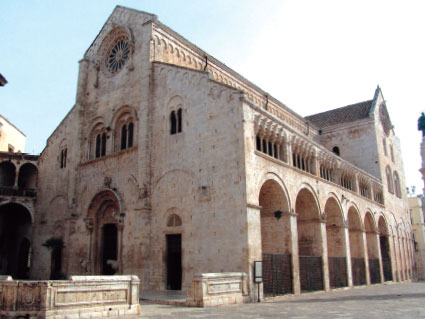




BITONTO (with a population of over 57,000 not far from Bari), between the area known as the Alta Murgia and the Adriatico, is known as the “City of oil”, because of its infi nite expanses of olive groves, which produce an excellent quality, unique tasting oil, renowned throughout the world. The itinerary for exploring Bitonto, land of olives with an ancient heart (the original settlement of the Peuceti people dates back to the 4th century BC), starts from the splendid Angevin tower (14th century), home of the Civica Galleria d’Arte Contemporanea, (contemporary art gallery) fl anking the 16th century gate Porta Baresana, which leads to the old town centre, an area that looks almost completely the same as it would have done in the Middle Ages. The same Piazza is also overlooked by the Renaissance Palazzo Sylos-Calò (16th century) home of the prestigious Galleria Nazionale della Puglia (art gallery), the only one of its kind in southern Italy. The majestic cathedral (12th - 13th century), one of the most mature existing expressions of Romanesque architecture, dominates the maze of narrow lanes making up the ancient town centre. There are many architectural treasures here: Palazzo De Lerma (18th century), Palazzo Spinelli (17th century), and Palazzo Vulpano-Sylos (15th century) with its majestic Catalan style doorway. Then there are the churches: from the ancient church of S. Caterina d’Alessandria (11th century) to the 18th century church of S. Gaetano, a treasure trove of ceiling master pieces by Carlo Rosa. The church of San Francesco d’Assisi (13th century) built in the gothic style, contains frescoes by Pandus and wooden statues from the late 16th century. It is also well worth taking the time to visit the renovated “Traetta” theatre (ex-Umberto I) built in the “Italian style” in 1838. Not far outside the old town, in the 19th century part of the town, the Museo Archeologico “De Palo-Ungaro” (archaeological museum) takes the visitor on a journey through the town’s most remote past. Amongst the gastronomic delicacies to taste are, focaccia baked in the stone ovens of the old town and seasoned with the area’s exquisite extra virgin olive oil, and the “bocconotto” a typical sweet dish made with ricotta. Bitonto enchants and fascinates with its art, beautiful monuments, cultural museums, its history, and its typical local products. Places to see: the churches: Co-cathedral of San Valentino, church of San Francesco d’Assisi, church del Crocifisso, church del Purgatorio; the palazzos:Palazzo Sylos-Vulpano, Palazzo Sylos-Calò; and Torrione Angioino (an Angevin Tower), Museo Archeologico (archaeological museum), Galleria Nazionale di Arte Moderna (national gallery of modern art).
Tourist Office
Via G.D. Rogadeo, 52 c/o Biblioteca comunale
+39 080/2254581 - fax 080/2254582
infoturismo.bitonto@gmail.com
Tourist Office
+39 080/3739912
Tourist Office
+39 080/3716306
Town Police
+39 080/3751014